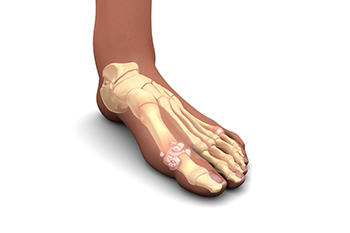Why Does Gout Develop?
Tuesday, 07 June 2022 00:00
Gout is a foot condition that affects the joints in the big toe. It is an extremely painful ailment that develops from excess uric acid levels in the bloodstream. Many patients have such debilitating pain that the weight of a bed sheet is too heavy. Gout may occur due to genetic reasons as well as eating foods that have high amounts of purines. There may also be medical reasons why someone develops gout. These can include having high blood pressure, being overweight, or having chronic kidney disease or diabetes. It often starts attacking the big toe and can spread to other parts of the body, if not treated promptly. An effective prevention method to reduce gout attacks can be a lifestyle change. This includes refraining from eating foods consisting of red meats, shellfish, and drinks that are made with large amounts of sugar. Additionally, it can help to start a gentle exercise program that can strengthen the body. Gout attacks can be properly diagnosed during a flare-up and X-rays may be taken. If you have gout it is strongly advised that you are under the care of a podiatrist who can help you to manage the pain and discuss effective prevention and treatment methods.
Gout is a painful condition that can be treated. If you are seeking treatment, contact Dr. Michael A. Wood from Foot Health Institute. Our doctor will treat your foot and ankle needs.
What Is Gout?
Gout is a form of arthritis that is characterized by sudden, severe attacks of pain, redness, and tenderness in the joints. The condition usually affects the joint at the base of the big toe. A gout attack can occur at any random time, such as the middle of the night while you are asleep.
Symptoms
- Intense Joint Pain - Usually around the large joint of your big toe, and it most severe within the first four to twelve hours
- Lingering Discomfort - Joint discomfort may last from a few days to a few weeks
- Inflammation and Redness -Affected joints may become swollen, tender, warm and red
- Limited Range of Motion - May experience a decrease in joint mobility
Risk Factors
- Genetics - If family members have gout, you’re more likely to have it
- Medications - Diuretic medications can raise uric acid levels
- Gender/Age - Gout is more common in men until the age of 60. It is believed that estrogen protects women until that point
- Diet - Eating red meat and shellfish increases your risk
- Alcohol - Having more than two alcoholic drinks per day increases your risk
- Obesity - Obese people are at a higher risk for gout
Prior to visiting your podiatrist to receive treatment for gout, there are a few things you should do beforehand. If you have gout you should write down your symptoms--including when they started and how often you experience them, important medical information you may have, and any questions you may have. Writing down these three things will help your podiatrist in assessing your specific situation so that he or she may provide the best route of treatment for you.
If you have any questions, please feel free to contact one of our offices located in Lansing, and Chicago, IL . We offer the newest diagnostic and treatment technologies for all your foot care needs.




